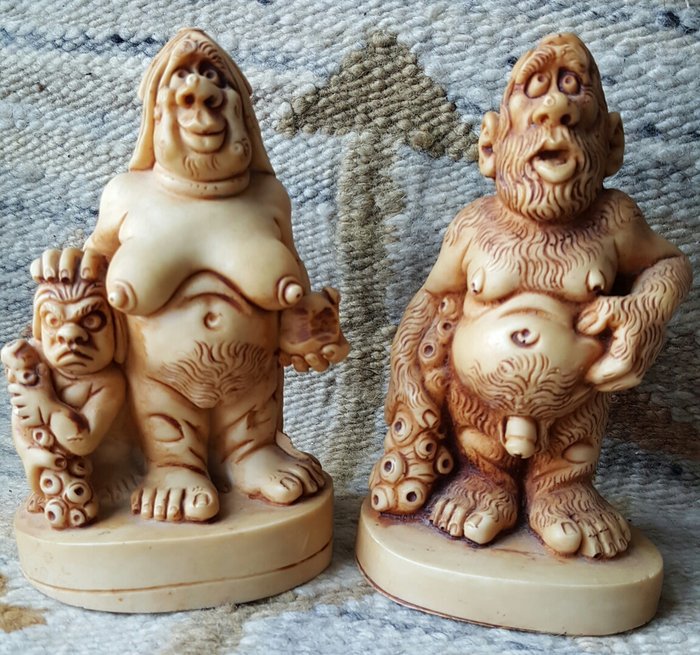"Venus" or Woman of Wellendorf
The Woman of Wellendorf, among other female forms, are some of the earliest instances of ‘mobile art’ that we have found. Mobile art is something small enough to carry with you, and does not seem to serve any purpose beyond being a piece of artwork (or does it?). Some of the original theories of the use and meaning these early art forms include representations of goddesses that are worshiped, children’s toys, and Upper Paleolithic pornography.
However they do offer us more clues about the ancient world if you look closer... such as the weaving and clothing that some of them are wearing.
For example the Woman of Wellendorf’s “hairdo.” Upon closer inspection, the design on her head is very deliberate. It starts in a knot at the top of her head, and circles around very regularly. This is not a design that can be created with a person’s hair- in fact its much closer to the style of weaving of a basket.

The “Venus” Figurines: Textiles, Basketry, Gender, and Status in the Upper Paleolithic
O. Soffer, J. M. Adovasio, and D. C. Hyland. Current Anthropology, Vol. 41, No. 4 (August/October 2000), pp. 511-537The University of Chicago Press on behalf of Wenner-Gren Foundation for Anthropological Research http://www.jstor.org/stable/10.1086/317381 .
Accessed: 01/08/2012 21:30
"...it is not unreasonable to think that, among the functions involved in this Upper Paleolithic masterpiece, it served as a blueprint or instruction manual showing weavers how to make such hats."- Soffer, "The Invisible Sex: Uncovering the True Roles of Women in History."
Maybe this mobile artwork served another purpose- as a blueprint to help remember how to weave the basket hat that was on her head!
Another example is the "Venus of Kostenki":

Another headpiece is the "snood," which is sort of like a woven hood.
The “Venus” Figurines: Textiles, Basketry, Gender, and Status in the Upper Paleolithic
O. Soffer, J. M. Adovasio, and D. C. Hyland. Current Anthropology, Vol. 41, No. 4 (August/October 2000), pp. 511-537The University of Chicago Press on behalf of Wenner-Gren Foundation for Anthropological Research http://www.jstor.org/stable/10.1086/317381 .
Accessed: 01/08/2012 21:30
In fact almost all of the female figurines found in Europe to Siberia are wearing headpieces, belts or upper body decorations.
The “Venus” Figurines: Textiles, Basketry, Gender, and Status in the Upper Paleolithic
O. Soffer, J. M. Adovasio, and D. C. Hyland. Current Anthropology, Vol. 41, No. 4 (August/October 2000), pp. 511-537The University of Chicago Press on behalf of Wenner-Gren Foundation for Anthropological Research http://www.jstor.org/stable/10.1086/317381 .
Accessed: 01/08/2012 21:30
Not all of these figurines show clothing though. In fact there is a huge variety in body shape and adornment of these pieces. Western European ones tended to have larger hips, and Eastern European ones tended to have larger stomachs and breasts, and the ones in the middle were in between the two extremes (Soffer:514). Some of their heads had headdresses and some did not.
It is also debated whether or not these objects really did not serve a practical purpose. They could have been used as loom wieghts or spindle whirls, and that explanation would make the basket on the Woman of Wellendor's head make even more sense. (Soffer:514)
All this to say, the Stone Age, better known as the Upper Paleolithic, probably did not look like this:

Sources:
Dr Lisa Maher's lectures
The “Venus” Figurines: Textiles, Basketry, Gender, and Status in the Upper Paleolithic
O. Soffer, J. M. Adovasio, and D. C. Hyland. Current Anthropology, Vol. 41, No. 4 (August/October 2000), pp. 511-537The University of Chicago Press on behalf of Wenner-Gren Foundation for Anthropological Research http://www.jstor.org/stable/10.1086/317381 .
"The Invisible Sex: Uncovering the True Roles of Women in History."Olga Soffer
Dr Lisa Maher's lectures
The “Venus” Figurines: Textiles, Basketry, Gender, and Status in the Upper Paleolithic
O. Soffer, J. M. Adovasio, and D. C. Hyland. Current Anthropology, Vol. 41, No. 4 (August/October 2000), pp. 511-537The University of Chicago Press on behalf of Wenner-Gren Foundation for Anthropological Research http://www.jstor.org/stable/10.1086/317381 .
"The Invisible Sex: Uncovering the True Roles of Women in History."Olga Soffer




Comments
Post a Comment